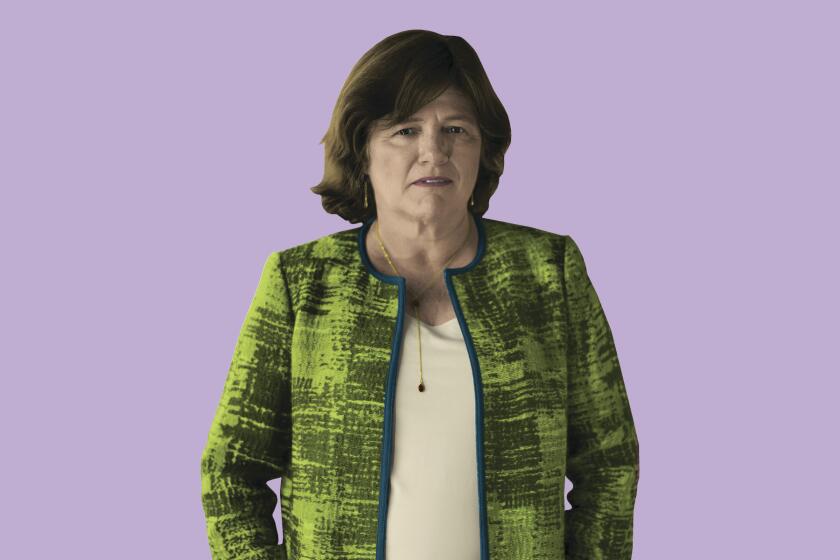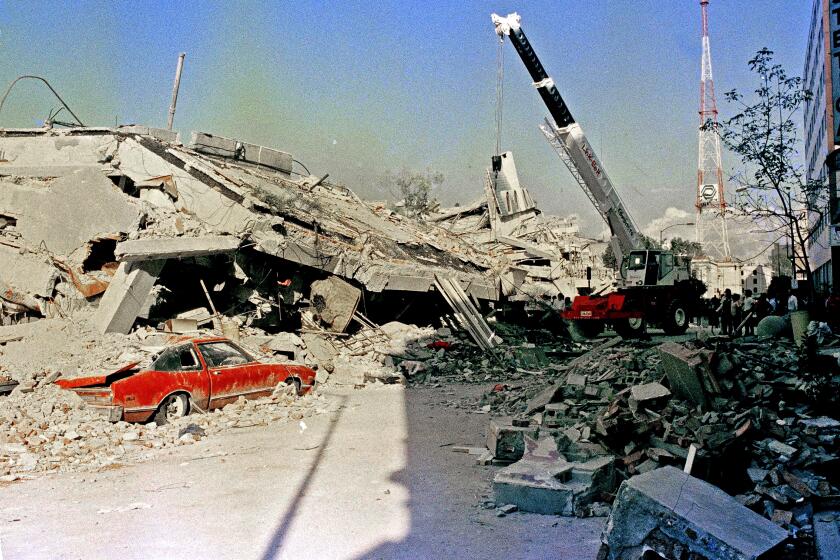How earthquakes happen: The science of a shake

- Share via
Californians have no doubt seen warnings about a major earthquake in headlines, science textbooks, Hollywood and more for years. And experts say we’re overdue. But to prepare for the Big One, it will help to know what one is.
What is an earthquake?
Earthquakes are the result of a fault line moving and releasing energy, or as Julian Lozos, assistant professor of geophysics at Cal State Northridge, describes it: a zipper unzipping.
No matter their size, earthquakes produce the same type of seismic waves. How intensely you feel these waves is based upon several factors, Lozos said.
The difference between a sharp, jerking earthquake and a slow, rolling one depends on how close you are to the epicenter. As you get closer, the seismic waves have less time to expel their energy and you’ll feel more force. The further away you are, the more lolling the waves will feel.
Where you are during the earthquake determines what you feel too, according to Doug Yule, professor of tectonics and paleoseismology at Cal State Northridge.
The Los Angeles Basin sits on “loose material, and the San Gabriel Mountains are rigid and solid rock,” Yule said. Loose material — which Lozos compares to a “bowl of Jell-O” — will slosh and roll, for example.
Why do they happen?
The earth is made up of layers, the topmost being the crust. That’s where we live — and experience earthquakes. Pieces of the crust, called tectonic plates, are constantly in motion. At the plates’ boundaries are lots and lots of faults, which run into each other as they slide and move, sticking and storing up energy.
Faults are a lot like people, Lozos said.
“We all have stress building up in our lives from a number of different sources, and we all hopefully have some sort of coping mechanism that allows us to kind of keep ourselves together under that stress,” Lozos said. “Eventually our coping mechanism isn’t enough, and we might flip out. And so, when a fault does that, the fault’s coping mechanism is friction, and the stress is coming from plate movement.”
What we consider to be an earthquake is just the tip of the iceberg, Yule said. There’s much more to it below the surface.
“So even at deeper levels, where [plates are] moving, let’s say at the rate your fingernails grow, one side is moving relative to the other side,” Yule said.
“The strong rocks that are not as deep, that are more shallow in the Earth’s crust, store the energy until that energy gets so big that it can’t hold it anymore, and it breaks and forms an earthquake.”
Earthquakes do not happen because of weather. That’s right — no such thing as earthquake weather. The USGS says that weather conditions at the time of earthquakes are about equally warm, cold, rainy and so on.
People are much more important than kits. People will help each other when the power is out or they are thirsty. And people will help a community rebuild and keep Southern California a place we all want to live after a major quake.
What is a fault?
Fault lines are the “fracture or zone of fractures between two blocks of rock,” according to the U.S. Geological Survey. In Southern California, there are 140 faults. The San Andreas fault system is the best known, spanning more than 800 miles of the state.
One type of fault consists of sections of earth rubbing against each other, moving in opposite directions. That’s what’s happening along the San Andreas fault. Other faults move over and under each other.
What is an epicenter?
Before we feel the shaking from an earthquake, the energy has to travel through layers of rock. The point in the Earth where the energy is first released is called the hypocenter, said Nate Onderdonk, professor of geological sciences at Cal State Long Beach.
An epicenter, then, is the point at the Earth’s surface above the hypocenter.
Foreshocks, main shocks, aftershocks?
Earthquakes in a sequence can be classified as foreshocks, main shocks and aftershocks. The main shock is the most powerful earthquake.
“So from a physics standpoint, they’re literally all just earthquakes,” Lozos said.
Foreshocks are the quakes that happen before a large earthquake. It isn’t until there is a quake that is larger than the previous ones that the initial episodes get “demoted” to foreshocks and the main shock is identified, Yule said.
The size of an earthquake is measured in magnitude. This is the number you see or hear in news coverage of the quake. The 2019 earthquakes in Ridgecrest, Calif., provide a good example. On the morning of July 4, an earthquake with a magnitude of 6.4 caused shaking throughout Southern California and beyond. The next afternoon, we felt another quake — a 7.1. Once all was said and done, the July 5 quake was classified as the main shock, the July 4 quake, a foreshock.
One note about magnitude. Each whole number increase — from, say, 3 to 4, or 6 to 7 — is a tenfold increase in amplitude. That’s why a magnitude 7 quake is so much more noticeable by so many more people than a 3.
Japan has a sophisticated system to alert its residents, and Mexico City has ubiquitous sirens. Is California’s early warning system ready?
Smaller quakes that follow the main shock are aftershocks.
“So imagine you’re rock climbing and your right hand slips, your left hand now feels more stress, and so you might have an aftershock in your left hand and it slips as well,” Onderdonk said. “So the aftershocks are in a way the crust adjusting to this new stress level around where the main shock broke the fault.”
But just like human emotions, the cycle is bound to start up again.
“The fault will have its earthquake, and it’ll have gotten rid of some of its stress, like how sometimes we’ll have a yelling fit, then you’ll feel better,” Lozos said. “But eventually, it all starts building up again until it happens again.”
What is the Big One?
It’s the destructive earthquake we worry about here in Southern California — the one you probably know you need to do more to prepare for.
Exactly how big and how bad it will be is impossible to say. Yule said Californians should think of it as “30 or 40 Northridge earthquakes to equal the energy release of one big San Andreas earthquake.”
But it is inevitable.
“The plates are moving on a daily basis, but they’re locked along the fault, so the idea is, the longer you wait, the bigger the earthquake will be because you’ll have more energy built up,” Onderdonk said.
The San Andreas fault has a large earthquake every 100 to 200 years, he added. The last major earthquake to occur along the San Andreas fault was in 1906 in San Francisco. Onderdonk said there’s potential for multiple smaller earthquakes to occur within a shorter amount of time, but the pressure that’s been building since 1906 has to be released at some point.
The theatrics of the state of California drifting into the Pacific Ocean are just that, Onderdonk said. “The motion of the San Andreas is lateral sliding past each other, so there’s not really any movement away. California isn’t moving toward the West relative to North America,” Onderdonk said. “The movies that show like a big chasm opening up — that’s not the case at all.”
Also: “Barstow is not going to become beachfront property,” Yule said.
But land will move — up to 15 feet in some areas, he said.
This movement will be permanent, said Seulgi Moon, professor of geology at UCLA, and will be visible as landslides, for example, or changes to the location of fences or roads.
And California will always be in motion.
“Eventually San Bernardino and the Greater L.A. area will be next to the Bay Area, and the baseball rivalry will be a lot worse,” Lozos joked. “And by eventually, I mean in like 20 million years.”
Earthquake preparedness is about communication, resilience and understanding and mitigating your risks. Our newsletter course will teach you how.
More to Read
Get earthquake-ready in six weeks
From building a kit to buying insurance, our Unshaken newsletter course will help you prepare.
You may occasionally receive promotional content from the Los Angeles Times.














